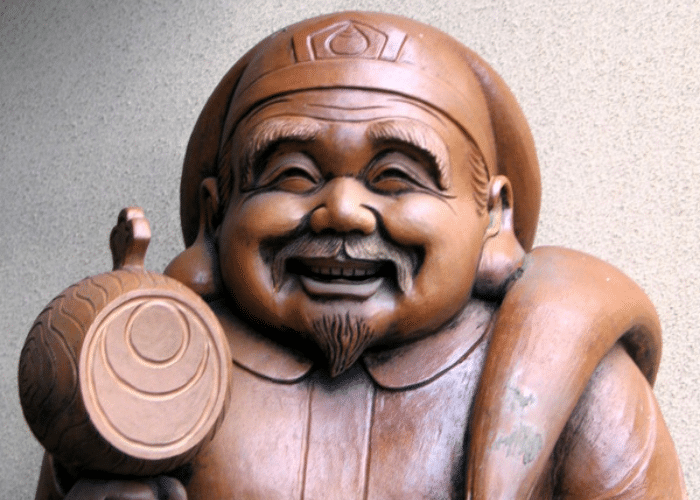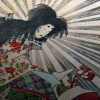
Japanese
Daikokuten: The Japanese God of Wealth and Grain
Daikokuten: The Japanese God of Wealth and Grain
How did a god of destruction become the smiling god of plenty? Keep reading to find out!
Daikokuten is a popular figure in Japan as one of the Seven Gods of Luck. As a symbol of plentiful food, fertility, and wealth his image is a common sight in shops across the country.
Like most of the Lucky Gods, however, Daikokuten did not originate in Japan.
Originally an Indian deity, the god who inspired Daikokuten is a very different sort of being. At a glance, any relationship between the two is almost impossible to make out.
Daikokuten is not a direct translation of this Buddhist god, but is instead a result of the mixing of native and foreign beliefs in Japanese folk religion. By combining two tenuously related gods, Japanese belief created an entirely new deity.
Lucky Daikokuten
In Japanese folk religion, Daikokuten is one of the Seven Lucky Gods.
He is usually shown with a wide face and a large, bright smile. He often wears a black cap and carries a large mallet.
Daikokuten is often shown sitting on bales of rice and surrounded by mice and rats. These point to one of his chief functions.
Daikokuten is a god of grain. He is often worshipped as a household god who is connected to the kitchen, but he is also seen as a patron of both farmers and cooks.
The rodents who are often seen with him are a symbol of the prosperity he brings. The presence of rats is a sign that there is abundant food.
While Daikokuten is often associated with prosperity in terms of food, like the other Lucky Gods he has also become a god of more general forms of wealth.
His mallet, called Uchide no kozuchi, shows his power over fortune. It is a magical item that appears in many popular stories; with a tap, it can create anything the wielder desires.
Because he is associated with grains and plenty, Daikokuten is sometimes thought of as a fertility god as well. He sometimes makes a somewhat obscene gesture known as the “fig sign” and carries a suggestively-shaped bifurcated daikon.
Such daikon were given as offerings to Daikokuten in some periods of history, but another form of worship became more popular.
The fukunusubi, or “theft of fortune,” involved images of any of the Seven Lucky Gods, but Daikokuten’s statues were most popular. A belief arose that a person would be granted good luck and wealth if they could steal an image of the fortune-granting god and not be caught in the act.
The practice became so popular that an end of the year market near one of Tokyo’s major Buddhist temples became associated with the disposal of such statues. Thieves could sell the images they had stolen, earning a bit of money and allowing the images to be resold to more traditional buyers.
Wholesome of Daikokuten’s worship involves theft, he is also used to protect against it. Along with Ebisu, he is a popular protective deity whose images are often displayed in small shops and restaurants to promote their success and prevent losses.
My Modern Interpretation
Daikokuten became popular in Japan as a cheerful god who could bring plenty. His origins, however, are much different.
Like most of the Seven Lucky Gods, Daikokuten did not develop in Japan. He was taken from a Buddhist deity who originated in India and was brought to Japan through China.
Daikokuten’s name is an almost direct translation to that of Mahakala, a god of death and darkness in both Buddhism and Hinduism.
So how did a terrifying death god become a cheerful god of fortune?
In India, Mahakala was associated with the destructive aspect of the divine. He could annihilate even time and space.
Although he was merciless, Mahakala was not necessarily evil. His destructive powers could be turned toward powerful demons that even the other gods could not fight.
Because of this, Mahakala was often seen as a protective spirit. Although he could destroy anything, he most often used his power to defeat great enemies that threatened humanity, the gods, and the earth.
Mahakala was introduced to Japan as a god of death who could also protect the world. When this happened, however, the people of Japan did not abandon their existing gods.
Like China, much of Japanese religion was built on syncretization. Buddhism and Shinto were often combined rather than being seen as two entirely separate faiths.
Sometimes this meant a god was adopted by both traditions. In the case of Daikokuten, however, it meant that newer Buddhist gods were combined with those of the native Shinto legends.
Mahakala became associated with a Shinto kami called Okuninushi. He was a descendant of Susanoo, who ruled the Underworld realm of Ne No Kuni.
In his legend, Okuninushi sought Susanoo’s help when his eighty brothers tried to kill him. He fell in love with Susanoo’s daughter and was subjected to a series of grueling trials before being allowed to marry her.
Once wed, Okuninushi was made the ruler of the earth. He defeated his brothers and became the head of all the terrestrial kami until the gods decided to install their own heavenly leadership.
In Japanese kanji, the first characters of Okuninushi’s name can be read as “daikoku.” Because they come from related words for darkness, the two deities were conflated into a new god.
While Okuninushi was not directly related to agriculture, his position as the ruler of the earthly kami gave him a connection to the land. This gradually evolved with Daikokuten into a connection specifically to the grains that the land produced.
The connection was probably helped by the stories of Okuninushi’s trials in Ne No Kuni. In one, he was trapped in a burning field and shown a safe hiding place by a helpful mouse.
Because mice were present when there was a surplus of grain, the image of Okuninushi being helped by the mouse linked him to the idea of abundance. Mahakala’s role as a protector furthered the idea of Daikokuten as a helpful god.
Because Japanese folk religion syncretized two dissimilar gods who were connected to death in some way, Daikokuten became a much different character than either of them. While his name retained its associations with darkness and death, he was seen as a helpful figure who brought prosperity and bounty.
In Summary
As one of the Seven Lucky Gods, Daikokuten is a popular figure in Japanese culture. His broad smile and symbols of plenty make him an identifiable symbol of prosperity.
Daikokuten is traditionally associated with agricultural plenty; he is shown with bales of rice and mice to show an abundance of food. This has made him a patron of agricultural workers and a household god of the kitchen.
This also makes him a god of fertility. His symbolism often includes both obvious and subtle references to human fertility as well as abundant crops.
Like the other Lucky Gods, Daikokuten eventually became associated with wealth in general in addition to his specific domain. His mallet has the ability to create treasure and his images attract all forms of wealth, not just good.
Diakokuten was originally adopted from a Buddhist deity, Mahakala. Unlike his Japanese form, however, this god was a terrifying force of destruction and darkness.
Because Mahakala’s destruction could be used against evil, however, he was often seen as a protective god. He entered Japan as a dark being who was nonetheless helpful.
Mahakala’s name was translated as Daikokuten in Japanese, but this brought him into close association with an existing Shinto kami. Okuninushi, the former ruler of the earth’s spirits, incorporated the same kanji in his name.
Okuninushi was not a god of agriculture, but his association to both the earth and the subterranean realm of Ne No Kuni helped to create this link in the figure of Daikokuten. As a protective god with these links, Daikokuten was adopted as a patron of farmers and their crops.
Diakokuten’s gradual evolution from the menacing force of darkness he had been in Indian culture. Through the syncretic beliefs of Buddhism and Shinto, Japan created a god of plenty out of a figure of destruction.







